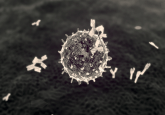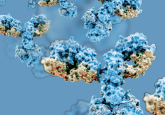From sensitivity to selectivity: transforming mass spectrometry imaging with targeted solutions
In this podcast, we spoke to Emmanuelle Claude, Consulting Scientist at Waters Corporation (Wilmslow, UK) and Andrew Bowman, Senior Scientist I at AbbVie (IL, USA). Together, they delve into the practical applications of mass spectrometry imaging (MSI), discuss its transformative impact on the bioanalytical landscape, and explore how a targeted MSI solution can be seamlessly integrated into a drug discovery workflow.
Podcast transcript
[00:09] Kadeja Johnson: Hello and welcome to our In the Zone podcast on mass spectrometry imaging, sponsored by Waters. I’m your host, Kadeja Johnson, and today I’m joined by Andrew Bowman and Emmanuel Claude.
[00:26] Andrew Bowman: My name is Andrew Bowman. I’m a senior scientist I with AbbVie, currently based out of Lake County. I did my PhD at the lab of Ron Herron at the Maastricht Multimodal Molecular Imaging Institute, which I still love to say: M4I. Also, just as a corollary to this, all of the views expressed here are my own views. I am an employee of AbbVie, but everything I say is what I think, not necessarily what AbbVie thinks.
[01:00] Kadeja Johnson: Thank you for joining us, Andrew. We also have Emmanuelle joining us.
[01:06] Emmanuelle Claude: Yeah, so my name is Emmanuelle Claude. So I am a consulting scientist at Waters and I am a specialist in mass spectrometry imaging. I’ve been doing mass spectrometry imaging for over 20 years now, starting with MALDI technology and I have got a really good background in DESI technology as well. I’m focused on developing application and collaboration to ensure that MALDI and DESI mass spectrometry imaging, we develop the right technology for our customers.
[01:41] Kadeja Johnson: Andrew, can you tell us: what is imaging and how does it help your research?
[01:48] Andrew Bowman: So in the context that we’re talking about here, we’re doing mass spectrometry imaging. And so we’re looking at thin tissue sections and we’re ionizing them in this specific case, using a stream of particles from a DESI probe, an electrospray ionization source and then we are desorbing things off the surface and then analyzing them basically pixel by pixel into a mass spectrometer.
[02:14] Kadeja Johnson: Amazing and how does it help your research?
[02:18] Andrew Bowman: So, in this particular case, a lot of the things that I do are in drug metabolism and disposition and I’m specifically in that disposition side of everything. So we’re looking to see where exactly a drug or metabolites are in, well, ex vivo, essentially, in this case. And so we’re looking to get very high spatial resolution information about where exactly the drug is going, what it’s interacting with, all that kind of fun stuff. And so this is one of those things that is becoming larger in pharma.
It’s still not quite as broad of an application as, say, like liquid chromatography mass spectrometry, but it’s providing different kinds of information that is very collaborative with LC–MS.
[03:10] Emanuelle Claude: Yeah, just to add to this, one of the workflows for LC–MS is to homogenate the sample. So you lose the localization information of a particular molecule within the sample, where here we don’t do this. We just leave the tissue intact. So we really can look at where the particular molecule is localized within tissue, whether it’s a homogeneous molecule, whether it’s a drug, whether it’s a metabolite, etc., etc.
[03:45] Kadeja Johnson: Awesome and coming off of that, Emmanuelle, what are the most critical parameters that you monitor?
[03:55] Emanuelle Claude: What we kind of monitor, really, what’s important within the experiment, is going to be how much of the molecule we can detect. So, for a particular molecule, how many different molecules we can detect within the experiments and also the spatial resolution. So, depending on, there is different MS imaging techniques. So, we’re using here the DESI for the ionization, but we also have a matrix-based technique, which is a laser, which is the MALDI technique, and depending on the technique, you can have some delocalization of the molecule. So, we really want to keep as pristine as possible the sample when we do the analysis. [I] don’t know if you want to add anything more, Andrew?
[04:19] Andrew Bowman: I will say that at least in my particular neck of the woods, one of the most important things we’re dealing with is sensitivity. A lot of the compounds that I am trying to find in these tissue sections are dosed at very low levels. We’re talking, you know, milligrams per kilogram of an antibody drug conjugate, and we’re looking for the drug that is conjugated to it that’s less than one percent of that total mass. So, we’re looking at like micrograms per kilogram of an animal and so whenever you’re dealing with things that are dosed that low, the most important thing becomes how sensitive is your piece of equipment? Can it detect that compound at all ex vivo?
[05:35] Kadeja Johnson: Awesome. Thank you. How does imaging work in practice from sample to image, as you just touched on it there?
[05:44] Andrew Bowman: Once you have the tissue mounted to the slide for the DESI workflow, you can just take that, scan the slide as like an optical image and then mount it to your DESI platform and you’re basically ready to go. If you’re going to do MALDI, which is matrix-assisted, then you do have to apply a MALDI matrix to that slide first. Then you can scan it, put it in your instrument and you should be good to go.
[06:10] Kadeja Johnson: Any comments, Emmanuelle?
[06:13] Emmanuelle Claude: No, I think Andrew did explain it really nicely. So, we prepare the sample on the glass slide and then we put that into the mass spec. Obviously, we have to define depending on the mass spectrometer that is chosen. So in our case here, we are talking about [a] targeted workflow, so we’re using a triple quad. So, we need to optimize the MRM transition, whether we do that in an electrospray or whether we have done that manually in DESI mode; and then we also have some other mass spec that are what we call untargeted or discovery approach, where at this point, we don’t know what we’re looking for. We have to obviously optimize the mass spec parameters.
In both cases, we will also optimize the DESI and the spray in a DESI is really the critical part, I would say. That’s where we probably spend most of the time before we do the MS acquisition. We want to have the same condition from the beginning of the acquisition to the end of the acquisition. This acquisition can last for hours, depending on the size of the sample, depending on the pixel size. And I think that would be pretty much the practical side that we have within the experiment. Before we go to the imaging final view, where the data has been processed and we look that into a HDI software in our case, but into a mass spec imaging software.
[07:46] Kadeja Johnson: That was very clear, thank you.
[07:46] Kadeja Johnson: Where is this technology, targeted MSI, already making an impact? How could this technology be a game changer in areas of oncology, drug development and personalized medicine?
[08:01] Andrew Bowman: For the kinds of stuff I’m working with, a lot of the mass spec imaging is already in use for toxicology. We see a lot of use for it because we are looking at a tissue sample and the pathologist says, “Hey, it looks like we have some sort of tox findings here. Can you tell me why we have tox findings there?” Because if you’re doing an H&E stain or an immunohistochemistry stain, you can differentiate your cell types. But exactly why one cell is undergoing extra stress is often missed. That’s where those mass spec imaging starts to come in, where we can look at it and go, we’re detecting exactly like the compound, we’re detecting its metabolites. We’re able to say whether or not the toxicity that we’re seeing there is from the compound that we’ve dosed, if it’s from something that the body turned that compound into.
It’s seeing a lot of use already that early in the pipeline. But one of the things that we’re working on now that’s sort of much later in development is — I have some clinical samples where these are actually from humans. These are skin biopsies where we’re able to start looking at these and determining whether or not there is a compound going where we expect it to go. And so I think that in sort of in the future of the industry here, for at least the pharmaceutical side of it, is mass spec imaging is seeing a lot more use as a very precise, sensitive tool to be able to determine the target engagement of a compound, essentially. No longer were we just going like, “oh, compounds in the blood or it’s in urine or it’s in feces”. We’re looking at it and being able to go, yes, not only is this compound getting into that person, not only is the body turning into something else, but I can tell you exactly where that’s going and whether or not that’s interacting with the thing that you want it to interact with.
[10:08] Emmanuelle Claude: And just to add to this, currently there is a radiolabel imaging to actually is an FDA-approved method to look at where the drug is going, or at least where the label attached to the drug is going. One of the issues with that is that if the drugs has been modified by the body and become metabolites, if that label is still attached to that metabolite, because you are visualizing the label, you can’t really differentiate between the drug and the metabolite. And one of the, I think, advantages to mass spec imaging in general is that we can differentiate whether we see the drugs or a metabolite.
And even worse, sometimes you’ll get a metabolite that loses the label. And so that’s completely silent in an autoradiography. You have to have some other technology to be able to see it.
[11:02] Kadeja Johnson: Thank you. Great answers there.
[11:04] Kadeja Johnson: The next question I want to ask is, how is targeted DESI imaging integrated into existing lab infrastructure or other mass spec workflows or techniques?
[11:17] Andrew Bowman: So the DESI workflow in this case, so for my setup here at AbbVie, the imaging lab is attached to everything that’s drug metabolism and disposition. So that side of it is all liquid chromatography. They’re all dealing with biofluids for the most part. And so they are working on a lot more of like the metabolite identification. They’re going through and saying, we’ve dosed this compound into an animal. What is every single thing that [the] body is turning that compound into? With the mass spec imaging side of it, just because we are more sensitivity-limited, because we are usually more substrate-limited, we’d have less to work with than a lot of the LC workflows. We are trying to keep everything in a much more targeted fashion because we’re trying to say: we know what we are looking for, can we see everywhere it goes in a tissue sample?
So, a lot of the things I’m doing are sort of piggybacking off of whatever the drug metabolism group has done to say like, here’s all the compound. Do you see any of these compounds in this tissue? And then sort of where that flows next is we’re working in conjunction with a lot of pathologists who are staring at tissue samples and going, here’s the sort of like cell-by-cell play of what we’re seeing. These cells over here seem to be under some extra stress. These are the cell types that we want to make sure the compound is getting to. And so we’re [a] very collaborative service sort of organization within AbbVie to be able to look at these things and go, everything about the drug is identified at one level and everything about the tissue is identified at another level. And we’re just kind of bridging that gap between drug identification and tissue distribution.
[13:22] Emmanulle Claude: Yeah, just to add to this, in another kind of type of labs where they’re not really interested or they don’t know what they’re looking for. So they’re going to do [an] untargeted discovery type of workflow. They basically would be next to maybe a pathologist. And they will be more looking at, I’ve got two different states of a disease or I’ve got a tissue where I’ve got a disease and unhealthy tissue in it. And they want to understand: what is the molecular profile between these different tissue types? They don’t have one molecule in particular of interest. It’s just a profile of the relative intensity of all these different endogenous molecules that are present within the tissue.
[14:13] Kadeja Johnson: Thank you.
[14:14] Kadeja Johnson: The next question I have is: One big challenge is data interpretation. How is this managed in your lab? Is there a role for AI or machine learning in how DESI data is processed or visualized?
[14:30] Andrew Bowman: Oh, for sure. So with targeted DESI imaging, one of the advantages you have versus what I call broad spectrum mass spectrometry. So that’s say like if you’re working with cyclic IMS (Ion mobility spectroscopy) or select MRT or something like that, where you’re looking at everything that you were able to desorb off the surface, thousands of molecules, all different kinds, that level of mass spec imaging, 100 percent there is a need for AI. Because if you’re looking at like trying to identify everything for a tissue from mass spec imaging and you’re looking at thousands of molecules, it’s so much information. It’s so data-rich. And some of the changes can be so subtle that having essentially like another set of eyes that is like AI to be able to look at that image is 100 percent necessary. I mean, mass spectrometrists have been using algorithms to be able to identify and look for specific areas of interest in a tissue for years, decades at this point.
Targeted DESI imaging doesn’t necessarily need that so much because of the fact that you are in like the specific work case that I’m using, I’m looking between four and six molecules. One of those is an internal standard. One is just sort of like a tissue marker. And then two of them are like different fragments of my molecule of interest so that I know that I’m seeing my molecule of interest. So it’s a little bit harder to claim that I really need it for the targeted DESI imaging. But as I’ve said, I work with a bunch of other like pathology groups. And whenever you start getting into here’s my DESI imaging and here’s my HNE and here’s my IHC and here’s my in-situ hybridization, all of a sudden, if you’re looking at so many different kinds of imaging modalities, you need something to be able to like overlay them, put them together, look for areas of interest between a whole bunch of data sets because I don’t know that I’ve ever met the person yet who is able to look at, say, RNA sequences and IHC and mass spec imaging and combine all that together into a cohesive whole and didn’t take 12 months to be able to do that for a single data set.
[16:53] Kadeja Johnson: The next question I want to ask is, what does the future look like for you? Is there a particular application breakthrough that this technology might help you solve?
[17:04] Andrew Bowman: Yeah. So whenever we’re talking about mass spec imaging and sort of its role in like pharmaceutical industry, at least, the thing that we always run into is we are combining this technology. We’re abridging technology, essentially. On the one side of this, we have the drug metabolism group. Everything that they’re doing is to be able to identify the drug and whatever the body turns it into. And on the other side of it, we have the pathology group who’s looking at tissue sections and identifying like very specific cell types and looking at it going: here’s one cell that is greatly important. It is an astrocyte in this brain. I need to know exactly what’s happening in that astrocyte. Is the drug getting to it? Is the drug turning into something else whenever it’s in that astrocyte?
And they cannot answer that information with like an immunohistochemistry stain.
On the other side of it, whenever you’re dealing with blood or bile, you can tell what the body is turning a compound into, but you can’t really say where exactly it is. What is it doing in a given cell? And so mass spec imaging is sort of this bridging group to be able to take all that information that we have learned from the drug metabolism side of it and all of the questions that we have from the pathology side of it and combine them in a way to be able to truly understand exactly what’s happening on a cell level with these compounds. Specifically with DESI, one of the most important things that we can now do is that it’s such a gentle technique for being able to get ions off the surface that I can take that exact same tissue section and do some of these pathology-style analyses on it.
That gets really important because whenever you’re talking about a single cell, you’re talking about something that’s, you know, five to 20 microns big. And so one of the older technologies was really to take a sample and then take like the serial section for that sample and do two different kinds of techniques on them, two different modalities, which is great whenever you’re dealing with something and you’re just trying to identify like tissue type. But whenever you’re sitting here going, I need to identify this specific cell, if you are in that cell at one section, the very next section could have an entirely different cell type in it. So, if what you need to know is cellular information, being able to combine your mass spec imaging with another modality in the exact same tissue slide means that I can now actually get to that level where we can do cell-by-cell analysis.
The use of mass spec imaging, I think, is in that sort of bridging between all the stuff we learn from blood and everything that we need to know in a tissue section.
[20:06] Kadeja Johnson: Thank you. I’ll move onto the next question I have.
[20:10] Kadeja Johnson: If you could sum things up in one sentence and the impact that this technology has had in your research, what would it be?
[20:17] Andrew Bowman: In a single sentence, if we’re going to limit this to like DESI, I think what it has done is provided a path for mass spec imaging to become pipeline relevant.
[20:38] Emmanuelle Claude: I would say, again, if we’re talking about DESI, in particular targeted DESI, I would say that the technology has come really so far and we have really made it accessible to non-mass spec imaging researchers. And we’re really trying to develop this technology for any scientist who has some biological questions that are relevant to have this kind of experiment being run, whether it’s for drug distribution, whether it’s for biomedical research. Yeah, this technology has come a long way and we’re very proud of all the work that we’ve done so far with this.
[21:24] Kadeja Johnson: Amazing. Thank you, Emmanuel and Andrew, for sharing your experiences and insights with us. I’m sure our audience will love it just as much. To our audience, you can find more resources on mass spectrometry imaging on our infographic and short video, which makes up the rest of this In the Zone feature and of course, you can visit Waters for even more information.
About the Speakers:
 Emmanuelle Claude
Emmanuelle Claude
Consulting Scientist,
Waters Corporation, UK
Miss Emmanuelle Claude has a master’s degree in Fine Chemistry and Business and a Master of Philosophy in Spectroscopy Analysis in Organic Chemistry and Biology. She is currently a Consulting Scientist in the Scientific Operations Department at Waters Corporation (Wilmslow, UK).
She started at Waters Corporation in October 2000 as an Application Chemist in the Proteomics and Genomics Marketing group, developing automated peptide mass fingerprint (PMF) MS methods using a MALDI-TOF mass spectrometer. Over the years, she has developed several methods in the proteomics analytical space using MALDI-TOF and naturally moved into starting the development of mass spectrometry imaging (MSI) at Waters Corporation nearly 20 years ago.
She has been involved with hardware and software R&D to ensure that the solutions are fit-for-purpose for the MSI community and beyond. She has worked extensively with the main MSI leaders in Europe and the US, such as Professor Heeren in the Netherlands, Professor Clench and Dr Bunch in the UK, and Professor Caprioli in the US. She has been a Principal Scientist since 2014, became a Consulting Scientist in 2021 and is now part of the MS imaging porfolio at Waters where data are generated for collaborations and marketing activities (i.e. application literature, customer presentation, papers, posters, etc.), as well as hardware and software requirements that are defined for the R&D teams. The team evaluates and develops new applications and methods for imaging by both MALDI and DESI mass spectrometry, and supports sales with customer visits and demonstrations in laboratories worldwide.

Andrew Bowman
Senior Scientist I,
AbbVie Inc (Chicago, IL)
Andrew Bowman is a drug metabolism and disposition scientist in the Quantitative, Translational, and ADME Sciences department of AbbVie, Inc. His focus has been on the development of new and targeted mass spectrometry imaging platforms and their use in the analysis of drugs in tissue. Andrew is a graduate of the doctoral program from Maastricht University’s (Netherlands) ‘Maastricht MultiModal Molecular Imaging Institute (M4I)’, where he focused on the detection and analysis of lipids in mass spectrometry imaging.
The opinions expressed in this interview are those of the interviewee and do not necessarily reflect the views of Bioanalysis Zone or Taylor & Francis Group.
In association with:







